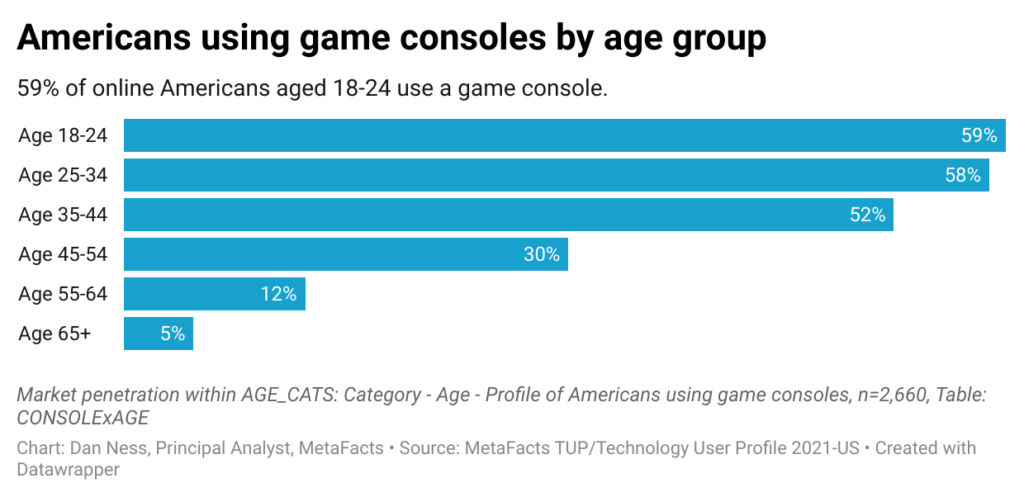Nearly a quarter of online Americans use a Sony game console, a higher penetration rate than competitors. Usage is most substantial among the youngish males, dropping off steeply above age 44. This MetaFAQs report profiles American Sony game console users by several critical demographic and behavioral factors distinctive from the average American online adult: age group, gender, age within gender, employment status, presence of children, household size, and life stage. Further, it details the percentage who use a VR headset and those who play games with a smartphone, PC, gaming PC, or tablet. It reports on American Sony game console users’ competitive position by those who additionally use Nintendo and Microsoft game consoles.
VR headset adoption
VR headsets are slowly and unsteadily working their way onto the heads of online adults. This TUPdate shows how penetration has expanded (and contracted) since 2018. By reviewing the activities that VR headset users do with their other connected devices – smartphones, PCs, tablets, or game consoles – this TUPdate profiles just who these VR headset early adopters are. Their creative, fun, collaborative, and educational activities point the way to possible hotspots of VR headset adoption.
Virtual reality headset use among socioeconomic groups
VR headsets have received recent attention again after more than a decade of on-again/off-again experimentation with limited market acceptance. While the overall penetration rate of actively-used VR headsets has reached 5% for the first time in 2021, usage rates vary considerably across socioeconomic groups. Having the means to acquire all that’s needed to fully enjoy VR headsets isn’t the only factor affecting adoption as even some upper-income groups are only nominally further ahead than other less advantaged groups. The groups being reported consider age group, employment status, household size, ethnicity, presence of children, educational attainment, and other socioeconomic factors.
Profile of American game console users
Dan Ness, Principal Analyst, MetaFacts, October 2, 2021
Profile of American game console users
- All online American adults who regularly use a game console
- They number 77 million – 35% of all online American adults
- Profiled by characteristics that are distinctive
- Only profiled by those characteristics which have an index of 80 or below and 120 and above – those which are 20% above or below the average by category
- Expressed as market penetration – the percentage of online adults within each group
- Distinctive characteristics profiles
- Age, age within gender
- Employment status
- Presence of children
- Household size
- Life stage (age, employment status, presence of children)
- Number of home PCs used
- Technology ecosystems
- Characteristics examined and not found to be distinct
- Educational attainment
Americans who regularly use a game console by age group
- Game console users skew younger
- Game console use is strongest among the youngest American adults
- Penetration among online Americans aged 18-34 is 58%-59%
- Beyond age 45, the rate drops steeply

Brand footprints and ecosystems – market progress update [TUPdate]
Popularity may not matter much in life—but when it comes to device and ecosystem adoption—it can mean quite a lot.
This TUPdate measures brand footprint and ecosystem adoption by how many people are using its devices. Microsoft Windows ranks as the most successful technology ecosystem, while Google’s Android and ChromeOS devices, Facebook, Amazon, Apple’s ecosystem, and HP’s brand footprint also hold substantial penetration rates. This TUPdate reports on the progress of seven top ecosystems and brands in reaching market penetration using the wave of research from TUP/Technology User Profile 2020 across the US, Germany, the UK, Japan, China, and India.
Ecosystem combination concentration by country [MetaFAQs]
It may seem like a jungle out there, but each ecosystem has one dominant product type and at least one other product or combination of products making up its market base. So, which ecosystems have the most multi-product combinations?
This MetaFAQs reports on the concentration of products within the bases of Microsoft Windows and Xbox, Facebook networks or Portals, HP PCs or printers, Amazon shoppers and Alexa users, Apple iPhones, iPads, Watches, and Macs, Google Android/ChromeOS smartphones and tablets, and Samsung smartphones, PCs, and tablets. This report measures online adults in the US, Germany, the UK, Japan, China, and India from TUP/Technology User Profile 2020, which is TUP’s 38th annual.
Highest ecosystem combinations [MetaFAQs]
Which tech ecosystems have the most dedicated customers? Many tech ecosystems have customers who use multiple products from that ecosystem. Some adults use two or more Windows PCs, or an Apple iPhone and an iPad, for example.
This MetaFAQs reports on the concentration of same-family combinations of products among online adults using: Microsoft Windows and Xbox, Facebook networks or Portals, HP PCs or printers, Amazon shoppers and Alexa users, Apple iPhones, iPads, Watches, and Macs, Google Android/ChromeOS smartphones and tablets, and Samsung smartphones, PCs, and tablets. This report measures online adults in the US, Germany, the UK, Japan, China, and India from TUP/Technology User Profile 2020, which is TUP’s 38th annual.
Highest ecosystem combinations [MetaFAQs]
Which tech ecosystems are strongest? One measure of ecosystem strength depends on how many products online adults use within that system. While Microsoft and Facebook take the lead in many countries, that is not always the case.
This MetaFAQs reports on the use of two or more products or services by online adults spanning: Microsoft Windows and Xbox, Facebook networks or Portals, HP PCs or printers, Amazon shoppers and Alexa users, Apple iPhones, iPads, Watches, and Macs, Google Android/Chrome smartphones and tablets, and Samsung smartphones, PCs, and tablets. This report measures online adults in the US, Germany, the UK, Japan, China, and India from TUP/Technology User Profile 2020, which is TUP’s 38th annual.
Highest ecosystem penetrations [MetaFAQs]
All it takes is one—especially when it comes to joining an ecosystems or brand footprint. A basic measure of ecosystem strength or brand footprint is how many customers are using at least one of its products or services.
This MetaFAQs reports on the use of one or more products or services by online adults spanning: Microsoft Windows and Xbox; Facebook networks or Portals; HP PCs or printers; Amazon shoppers and Alexa users; Apple iPhones, iPads, Watches, and Macs; Google Android/ChromeOS smartphones and tablets; and Samsung smartphones, PCs, and tablets. This report measures online adults in the US, Germany, the UK, Japan, China, and India from TUP/Technology User Profile 2020, which is TUP’s 38th annual.
Game-playing trends – convenience gamers, dedicated gamers, and device-gamers [Highlights]
Overview Playing games is a regular activity for most adults whether using game consoles or gaming PCs, or any of their connected devices – mobile phones, tablets, or PCs. Convenience Gamers – those using only a connected device to play games – have near-equal market penetration to Dedicated Gamers – users of game consoles or…

